Biodiversity Hotspots
A Hotspot in general language is an area/place/ region with high activity of a particular thing/ species/ event. Norman Myers, a biologist, in the year 1988 has come up with the term Biodiversity Hotspot as a biological region with a threat to endemic plants and ‘loss of habitat’. There are 36 Biodiversity hotspots in the world that covers around 2.4% of the earth’s surface which hosts more than 50% of world endemic plants and more than 40% of endemic species of birds, mammals, and amphibians. The North American Coastal Plains is the latest addition to the list of Biodiversity Hotspot of the world to become the 36th Biodiversity Hotspot. A region to get the status of a biodiversity hotspot has to have the following two criteria:
- Endemism – At Least 1,500 species of its vascular plants must not be found anywhere else on the Earth. Such unique species of plants are known as endemic plants or native to that particular region or place. These plants are almost impossible to replace if lost completely.
- Habitat Loss – If around 70% of the native plantation of the region is lost, then it is deemed to be a Biodiversity Hotspot.
Significance of Biodiversity Hotspot
- These biodiversity hotspots are the home to thousands of such endemic organisms, plants, and vegetation. Thus, have a huge impact on the ecosystem and biosphere.
- All these hotspots of the world are the life support system for the earth’s environment, ecosystem, and human beings.
- These hotspots are helpful in many ways like protecting natural resources like pure water, soil, maintenance of the ecosystem, controlling pollution and recycling the nutrients of the ecosystem.
- Biodiversity hotspots are also a good source of many of the medicinal resources, pharmaceutical drugs, and wood products.
- Hotspots are also a great place for research and education-related activities for the betterment of the human race.
Biodiversity Hotspots in India
A biodiversity hotspot in India is a region that is an active reservoir of endemic plants, animals, organisms, etc, whose vegetation is in danger or threatened and needs to be conserved for the betterment of the ecosystem and environment. There are 4 biodiversity hotspots in India, They are
- Himalaya: Includes the entire Indian Himalayan region (and that falling in Pakistan, Tibet,
Nepal, Bhutan, China and Myanmar) - Indo-Burma: Includes entire North-eastern India, except Assam and Andaman group of
Islands (and Myanmar, Thailand, Vietnam, Laos, Cambodia and southern China) - Sundalands: Includes Nicobar group of Islands (and Indonesia, Malaysia, Singapore,
Brunei, Philippines) - Western Ghats and Sri Lanka: Includes entire Western Ghats (and Sri Lanka)
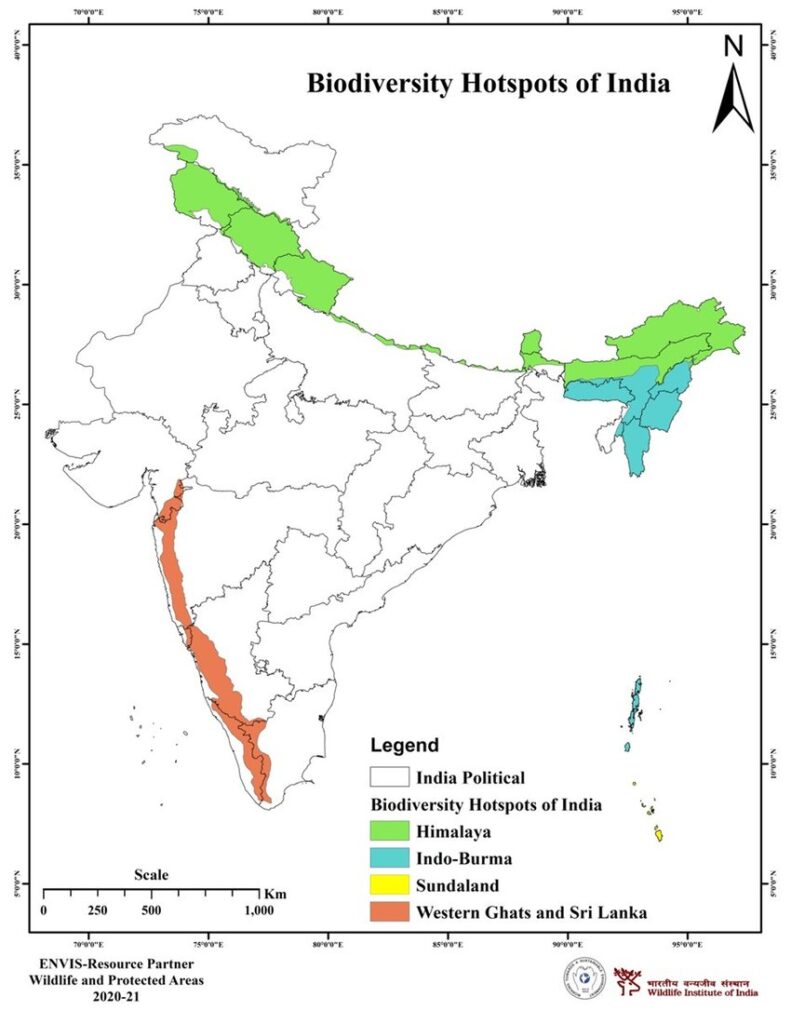
Himalayas Biodiversity Hotspot
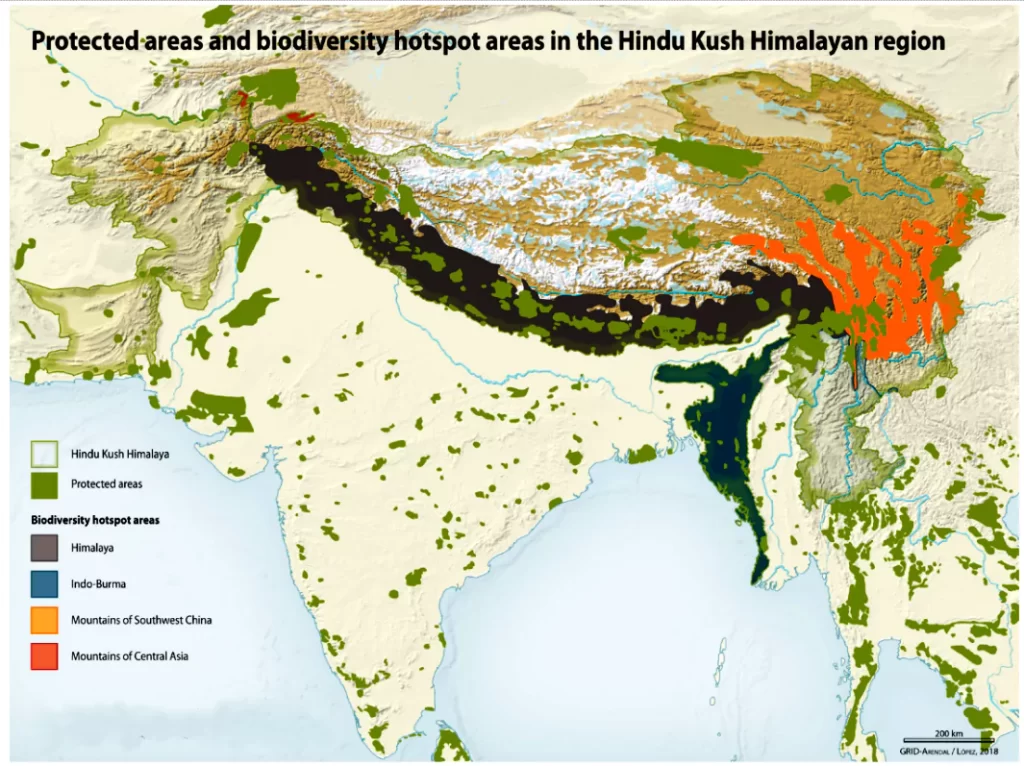
The Himalaya is divided into two parts: The Eastern Himalaya and the Western Himalaya.
- Eastern Himalaya – It covers part of Nepal, Bhutan, the northeast Indian states of West Bengal, Sikkim, Assam, and Arunachal Pradesh, southeast Tibet (Autonomous Region of China), and northern Myanmar.
- Western Himalaya – It covers part of Kumaon-Garhwal, northwest Kashmir, and northern Pakistan.
In the Himalayas, there are around 3,160 endemic species of plants, 12 endemic species of mammals, 15 endemic species of birds, 48 endemic species of reptiles, 42 endemic species of amphibians, and 33 endemic species of freshwater fishes.Some of the endemic plant species consist of Tetracentraceae, Hamamelidaceae, Circaesteraceae, Butomaceae, Stachyuraceae, Rhododendron, Primula, and Pedicularis. The largest family of flowering plants in the hotspot is the Orchidacea. There are around 750 species of Orchids found in Himalayas and Ermania himalayensis is a unique plant that was discovered on the slopes of Mt. Kamet in the northwestern Himalayas.
Threats:
- Despite their apparent remoteness and inaccessibility, the Himalayas have not been spared
human-induced biodiversity loss. - The steadily increasing population in the hotspot has led to extensive clearing of forests and grasslands for cultivation, and widespread logging. Both legal and illegal logging often occurs on extremely steep slopes, resulting in severe erosion.
- The conversion of forests and grasslands for agriculture and settlements has led to large-scale deforestation and habitat fragmentation in Nepal, and in the Indian States of Sikkim, Darjeeling, and Assam.
- Overgrazing by domestic livestock, including cattle and domesticated yak, is widespread in the lowlands and alpine ecosystems.
- The flora of fragile alpine meadows has been overexploited for traditional medicine
(because medicinal plant collectors invariably uproot the entire plant, regrowth is retarded). - Unplanned and poorly managed tourism has led to environmental deterioration.
- Political unrest, often in the form of insurgencies, also threatens the integrity of some protected areas.
- Poaching is a serious problem in the Himalayan Mountains, with tigers and rhinoceros hunted for their body parts for traditional Chinese medicine, while snow leopards (Uncia uncia, EN) and red pandas (Ailurus fulgens, EN) are sought for their beautiful pelts.
- Other threats to biodiversity and forest integrity include mining, the construction of roads and
large dams, and pollution due to the use of agrochemicals.
Indo-Burma Biodiversity Hotspot
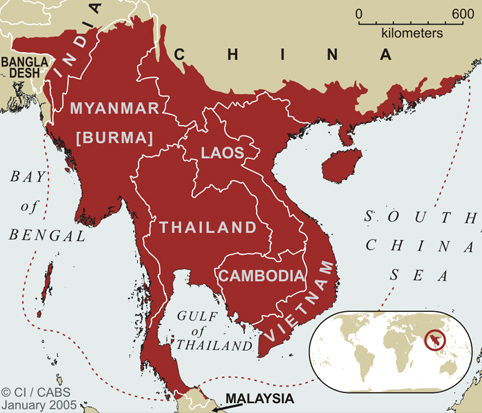
It encompasses around 2,373,000 square kilometers of the Ganges-Brahmaputra lowlands. The transition to the Sundaland Hotspot in the south occurs on the Thai-Malay Peninsula, the
boundary between the two hotspots is represented by the Kangar-Pattani Line, which cuts across
the Thailand-Malaysia border. The Indo-Burma hotspot has now been more narrowly redefined as the Indo-Chinese subregion. In the Indo-Burma, there are around 7,000 endemic species of plants, 73 endemic species of mammals, 64 endemic species of birds, 204 endemic species of reptiles, 154 endemic species of amphibians, and 553 endemic species of freshwater fishes. Since 1992, six large mammal species have been discovered and they are known as
- Antlered muntjac
- Annamite muntjac
- Grey-shanked douc
- Annamite striped rabbit
- leaf deer
- Saola
Bird life in IndoBurma is also incredibly diverse, holding almost 1,300 different bird species, including the threatened white-eared night-heron, the grey-crowned crocias, and the orange-necked partridge.
Threats:
- Indo-Burma was one of the first places where humans developed agriculture, and has a long
history of using fire to clear land for agriculture and other needs. - This has contributed to widespread forest destruction; tree plantations (teak, rubber, oil
palm) have replaced large areas of lowland forest, while coffee, tea, vegetable crops and
sugarcane plantations threaten montane and hill forests. - Other threats to forests include logging, mining for gems and ore, firewood collection, and charcoal production.
- Freshwater floodplain swamps and wetlands are destroyed by draining for wet rice cultivation, particularly in Thailand, Myanmar and Vietnam.
- Rivers have been dammed in order to store water to generate electricity for countries’ economic growth, or for export to neighboring countries to generate foreign exchange earnings.
- Chinese demand for turtles, snakes, tigers, and other species has depleted populations to the brink of extinction in just a few year.
Sundaland Biodiversity Hotspot
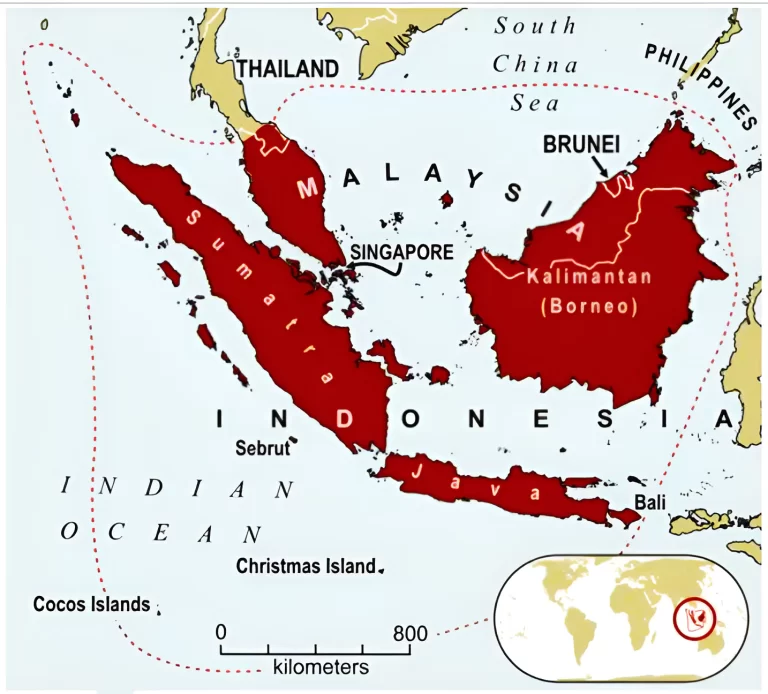
It consists of the western half of the Indo-Malayan archipelago and has two largest islands in the world known as
- Borneo which is spread over 725,000 km² of land
- Sumatra which is spread over 427,300 km² of land
There are around 25,000 endemic species of plants, 172 species of animals, 142 species of birds, 243 species of reptiles, 196 species of amphibians, and 350 species of Freshwater Fishes. Notable plants consist of a member of the genus Rafflesia in the Hotspot. One of these, Rafflesia arnoldii, has the largest flowers in the world, measuring up to one meter in diameter. Also, there are rare species of Southeast Asia Rhino species found in the hotspot. Populations of the orangutan, found only in this hotspot, are in dramatic decline.
Sundaland is bordered by three hotspots. The boundary between the Sundaland Hotspot and the
Indo-Burma Hotspot to the northwest is here taken as the Kangar-Pattani Line, which crosses the
Thailand-Malaysia border. Wallacea lies immediately to the east of the Sundaland Hotspot,
separated by the famous Wallace’s Line, while the 7,100 islands of the Philippines Hotspot lie
immediately to the northeast. Sundaland is one of the biologically richest hotspots on Earth, One plant family, the Scyphostegiaceae, is confined to the hotspot and is represented by a single tree species, Scyphostegia borneensis from Borneo.
Threats:
- The most significant threat facing Sundaland’s biodiversity is forest destruction. Some of the threats to the region’s forests include rubber production, pulp production, and commercial and illegal logging.
- Rapid road construction increases the extent and speed of deforestation, by providing access for loggers, settlers, and miners.
- In recent years, fires have become a major threat to the forests of Sundaland. Tropical forests do
not naturally burn, but logging operations create flammable conditions by leaving fuelwood on the forest floor and by exposing the understory to drying. - One of the most insidious threats to the fauna of Sundaland is the wildlife trade.
- Indonesia’s massive cage bird trade has also placed a number of species such as Bali Starling and Straw-headed bulbul (Pycnonotus zeylanicus, VU) under serious threat; the latter species, once common across its range, is now confined largely to remote areas.
Western Ghats Biodiversity Hotspot
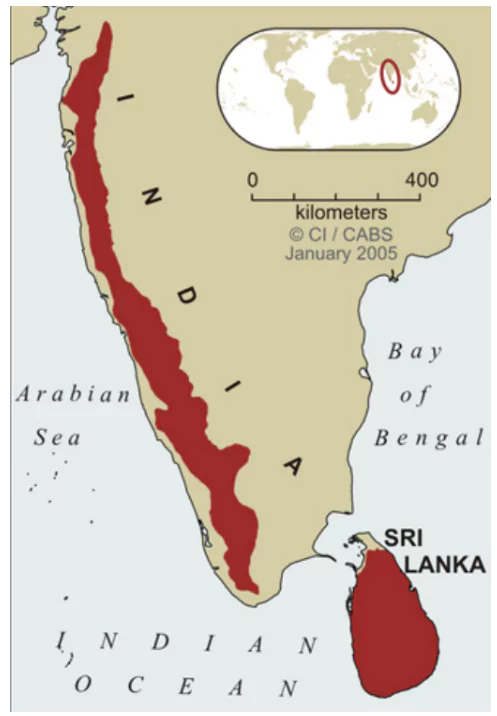
The Western Ghats are also known as the Sahyadri hills that are formed by the Malabar Plains and mountain ranges running parallel to India’s western coast, about 30 to 50 kilometers inland. There are around 3,049 endemic species of plants, 18 endemic species of mammals, 35 endemic species of birds, 174 endemic species of reptiles, 130 endemic species of amphibians, and 139 endemic species of freshwater fishes. Some prominent genera and families of flora consist of Impatiens, Dipterocarpus, Calamus etc. The only gymnosperm tree, Podocarpus (= Nageia) wallichianus, is also endemic. The Agasthyamalai Hills have the highest levels of plant diversity and endemism. The region also houses important populations of Asian Elephants, Indian Tigers, and the Endangered Lion-tailed Macaque. Freshwater fish endemism is extremely high as well, with over 140 native species.
Threats:
- Extremely high population pressure in both countries of this hotspot has seriously stressed the
region’s biodiversity. - Encroachment into protected areas further reduces the extent of forests.
- Grazing by cattle and goats within and near protected areas causes severe erosion on previously forested slopes.
- Uncontrolled tourism and forest fires are additional concerns.
- The growth of populations around protected areas and other forests has led to increasing human wildlife conflict.
